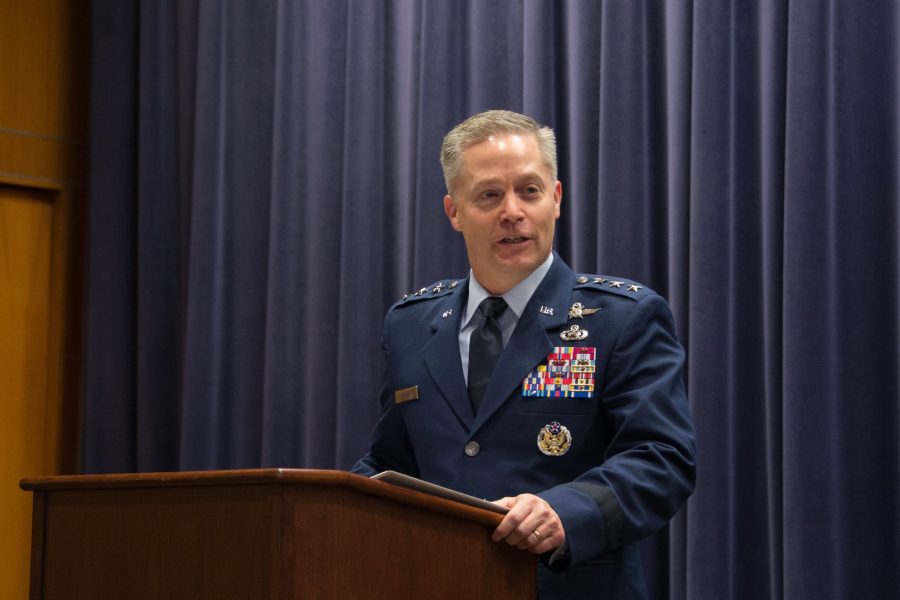ORLANDO, Fla.—The Air Force is using its first information warfare cell to support cyber operations, part of a new approach to digital, “gray zone” combat.
The IW cell brings together experts in intelligence, surveillance, and reconnaissance; electronic warfare; cyber; information operations; and public affairs, according to 16th Air Force commander Lt. Gen. Timothy Haugh. It is helping tackle overarching problems in the cyber realm including U.S. election security, protecting air defenses, and rooting out malign influence on networks.
The cell will be a pivotal player in 16th AF’s evolving structure. Haugh said the organization’s multiple operations centers will merge into a singular hub under one commander on March 16. Officials found those ops centers were focused on the same problems but were split up by specialty, limiting what they could do together.
As the 616th Operations Center handles daily intelligence-gathering, offensive and defensive missions in the air, on cyber networks, and across the electromagnetic spectrum, the IW cell will pull together the assets needed as the “integration point” for a particular response.
That could mean “naming and shaming” an entity for bad behavior through public affairs, supplying a combatant commander with helpful intelligence data, or reacting in the cyber and electronic spheres.
Haugh told Air Force Magazine the first IW cell will serve as a template for how 16th AF could ramp up its capacity in the coming years. Air Combat Command will ultimately decide how many cells to deploy, but Haugh said he has recommended offering at least one to both the Air Force’s components in Europe and the Indo-Pacific.
Here’s how 16th AF assets can help military bosses in new ways:
- The organization can figure out which intelligence resources are working on a Russian encroachment into Europe, for example, and pair them with another part of the enterprise that handles targeting.
- A nearby ISR plane could also share its data to offer a better picture of what’s happening in the area.
- Cyber elements could jump in if needed.
In the past, “We never would have been able to connect those dots,” Haugh said.
“Leveraging some of our intelligence capabilities to be able to identify that activity, whether it’s something with foreign special operations forces … and being able to publicly disclose that, whether that’s using our imagery capabilities or our full-motion video, those are the concepts that we’re getting greater and greater demand [for] from each of our air components and combatant commands,” he said.
Sixteenth Air Force will help out with a major U.S. European Command exercise in the next few months as well. Defender-Europe 2020 is the “largest deployment of troops from the United States to Europe in more than 25 years,” with 20,000 U.S. troops, according to the Army. Haugh said 16th AF is responsible for integrating all defensive cyber capabilities for that exercise, and will lend ISR and targeting expertise to assist the buildup in new ways.
In conjunction with U.S. Cyber Command, the Numbered Air Force attempts to stem the spread of malware and halt Russian disinformation tactics.
“We have deployed defensive forces to foreign nations, in partnership with those nations, [and] been able to gain samples of malware from those networks and publicly expose them,” Haugh said. “Those would have been tools potentially used to target our elections, our election infrastructure, or candidates, and we’ll publicly expose them.”
Since combining 24th and 25th Air Forces—which respectively oversaw cyber and ISR operations—into 16th AF last October, ACC has started working through what Air Force cyber personnel could need to grow in size and capability. Haugh did not elaborate what new products the group might need to do that, but said 16th AF is looking at consolidating as many as 65 defensive cyber tools down to 12.
On the intelligence side, ACC is still considering how to better mine publicly available information like social media posts for information warfare purposes. As USAF looks to scale back its RQ-4 Global Hawk fleet and stop production of MQ-9 Reapers, Haugh signaled 16th AF could continue meeting commanders’ demand for intel data through other means of collection.
Haugh also indicated the Air Force could stand up a wing to handle spectrum warfare, an area the service deeply studied in 2018. Brig. Gen. David Gaedecke, who ran the Air Force’s deep dive into electromagnetic spectrum operations, is joining 16th AF as its vice commander.
The organization is considering “what is required if you’re going to compete in the spectrum, and what we see in the evolution of warfare,” Haugh said.
“What is the intelligence required to inform that conflict, and doing it at a scale and pace to be able to identify what’s happening in the spectrum, and be able to get that to any platform that’s going to operate, is an area that we’re spending time and energy with inside of Air Combat Command.”
He added that the military doesn’t need any new authorities or legal changes from Congress to accomplish its job in cyberspace.
“We can apply the intelligence resources to understand, with behavioral experts that can now inform what are the right options. Is it best to publicly disclose, is it best to leverage our teammates in the State Department to work through a country team with various nations building alliances, or is it something where we produce a short-term outcome, to be able to stop a specific activity?” Haugh asked. “That’s now a menu we can talk about, whereas previously, these were all disparate activities. We can talk in a much more coherent, integrated fashion.”
